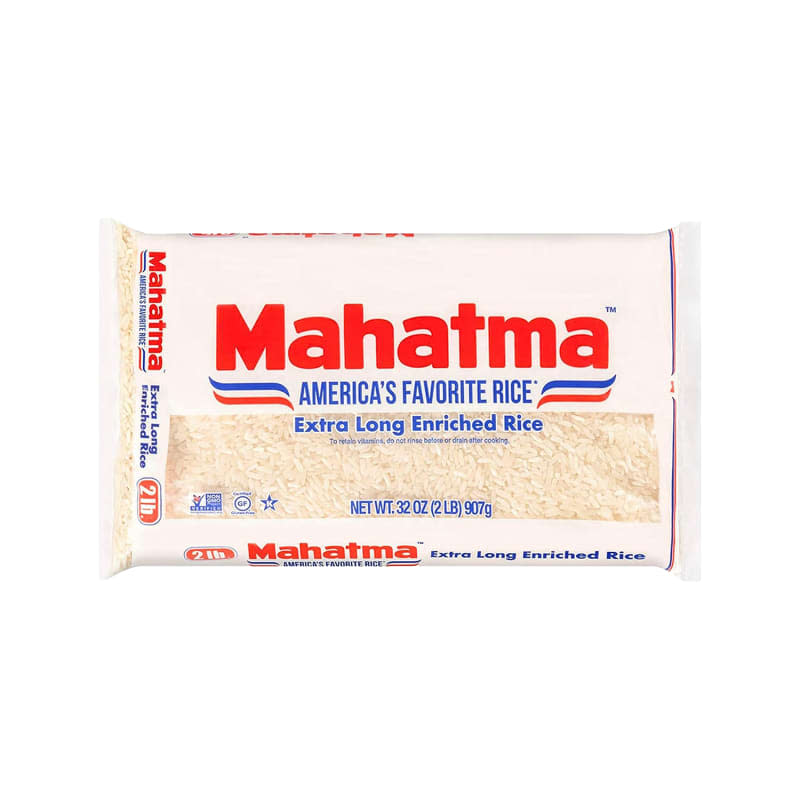We Tried the 5 Best Methods for Cleaning Gunky Flower Vases, and the Winner Was a Total Curveball
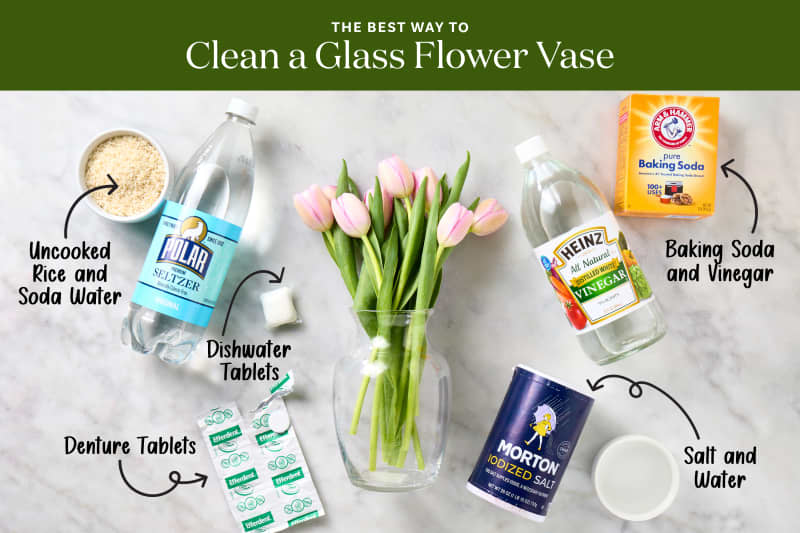
Spring is in full swing in my neck of the woods, and that means it’s time for displaying fresh cut flowers in every nook and cranny of my home (although I do enjoy them year-round). I always have a vase of alstroemerias or some other long-lasting cut flower on our kitchen table around this time of year — seeing them instantly uplifts my mood, and they’re perfect if you’re sensitive to smells (they’re essentially scent-less!).
This year, I plan to grow my own flowers, so in preparation I got out a bunch of my glass flower vases. During a recent stop at the store, I couldn’t resist grabbing some tulips and daffodils to make a delightful little display. But as beautiful as the DIY bouquet was, they left quite the mess in my narrow, hard-to-clean glass vases. I was left with vases that were empty but covered with sticky gunk and some not-so-sweet aromas. Once the grungy stuff dried in the vases, it was time to get to work.
I decided it was a perfect opportunity to put the best glass vase cleaning methods to the test to see which works best. I tested five different popular methods on my dirty flower vases, and was shocked by the winner. And good news: It’s probably sitting in your pantry as we speak.
Add a handful of dry, uncooked rice to the vase and add soda water until it’s about three-quarters full. Cover the opening with your hand and shake the rice and soda water around. Then dump out the mixture, fill the vase with warm water, and dump it out again.
How We Tested the Methods to Clean Glass Flower Vases
For each of the five methods, I let my bouquets of chamomile, daffodils, and tulips get funky for a few days, before tossing them and tending to the vases. Each of the vases was made of a thick glass and had a narrow opening at the top. The five methods I tested were denture tablets, salt and water, dishwasher tablets, baking soda and vinegar, and uncooked rice and soda water.
The Ratings
To compare methods, I rated them based on how easy they were to use, how well they performed, how long they took relative to the other methods (a high score means less time), and overall. Each component is rated on a 1 to 5 scale, with 1 being the worst. Here’s how the testing went!
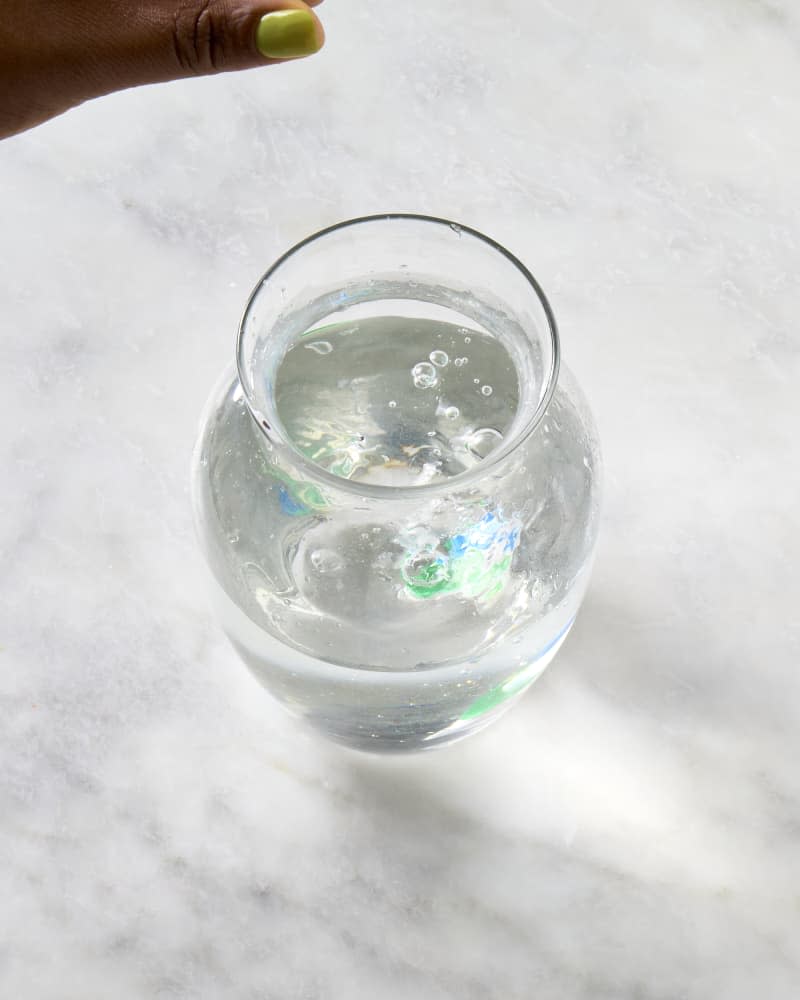
Glass Vase Cleaning Method: Dishwasher Tablets
Ease of use: 2/5
Performance: 3/5
Total time: 2/5
Overall: 2.5/5
The method: To use a dishwasher tablet to clean a glass vase, I cut open my dishwasher tablet, which was encased in plastic, and filled the vase about three-quarters full with warm water. Then, I squeezed the contents of the tablet into the vase, let the solution sit for about an hour, and dumped it out before rinsing.
How it went: I felt like opening up the dishwasher tablet was more trouble than it was worth. A hard tablet without a plastic encasing would also have been difficult to chop up, and one with liquid contents would have been messy. I also didn’t like getting the detergent on my skin. Plus, dishwasher tablets aren’t cheap! I didn’t like using one to clean just one (small) item. To top it off, the dishwasher tablet solution, which required a relatively long soaking time, didn’t work all that well — the vase was cleaner than it was before, but not crystal clear by any means. I’ll pass on this method in the future.
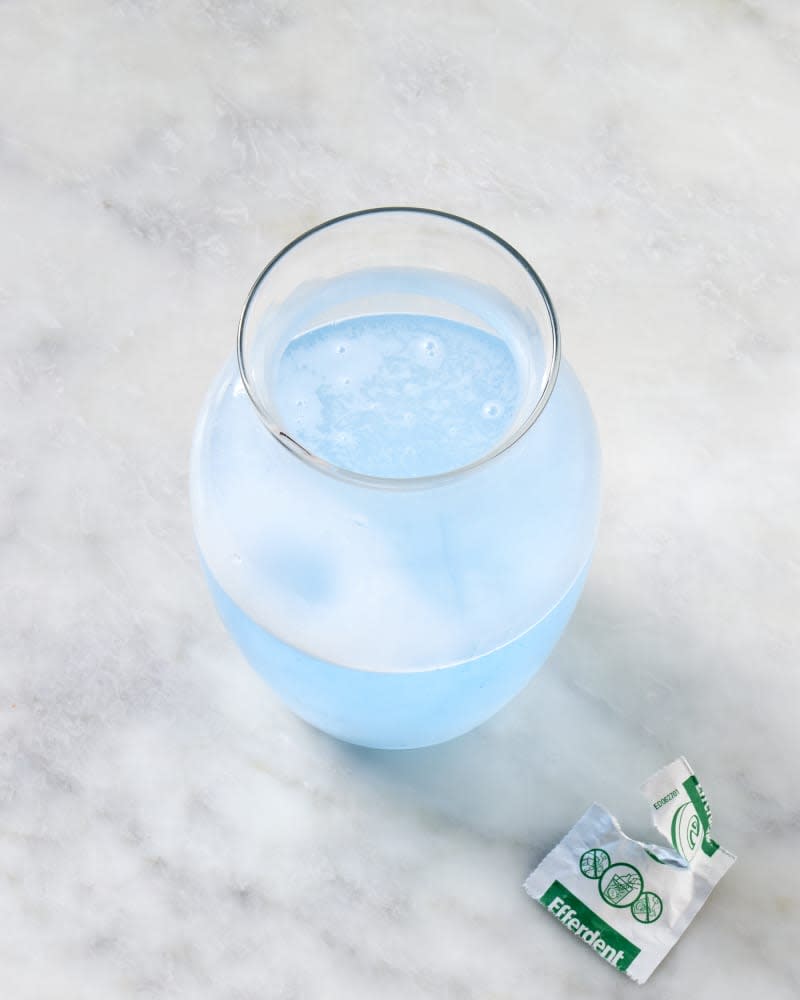
Glass Vase Cleaning Method: Denture Tablets
Ease of use: 4/5
Performance: 3/5
Total time: 3/5
Overall: 3/5
The method: To use a denture tablet to clean a flower vase, I filled the vase about an inch or two from the top with warm water and added one denture tablet to the water. I needed to break up the denture tablet to fit into the small mouth of my vase, then waited about 15 minutes for the tablet to fizz, and then I dumped out the water and rinsed out the vase.
How it went: This method was relatively easy to use, with one big caveat: I happened to have denture tablets on-hand, both because my daughter uses them to clean her retainer, and also because I’ve used them in the past to clean other kitchen items. If someone didn’t already have denture tablets on-hand, I don’t think you need to go get some to try this method, although they are inexpensive (only about 4 cents a tablet) and have plenty of uses. Using a denture tablet was quite hands-off in terms of scrubbing, though, because the fizzing of the tablet did all the work. That said, while the denture tablet did remove some of the gunk that had been left in the vase, it didn’t completely clean it out, especially compared to some of the other methods. I won’t be adding this method to my arsenal either.
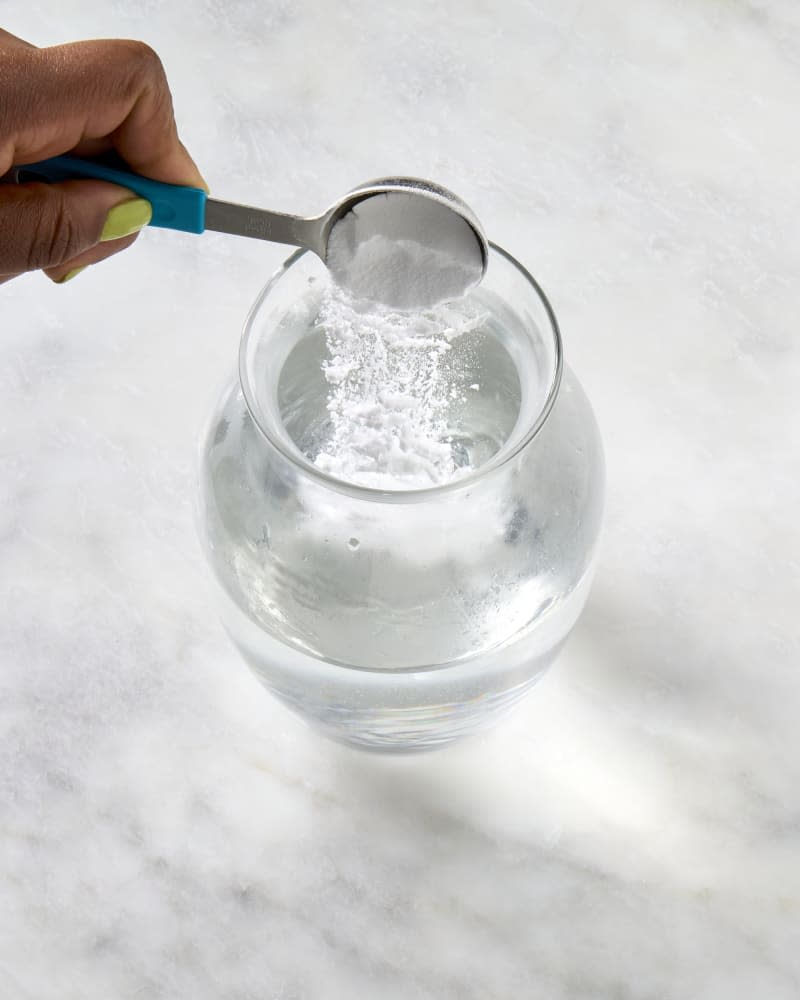
Glass Vase Cleaning Method: Baking Soda and Vinegar
Ease of use: 4/5
Performance: 4/5
Total time: 4/5
Overall: 4/5
The method: To use baking soda and vinegar to clean my flower vase, I filled the vase up about three-quarters full with warm water, added about a tablespoon of baking soda, and then splashed in a glug of distilled white vinegar. I let it sit and fizz for a few seconds and then covered the top and swirled the contents around in the vase.
How it went: The baking soda and vinegar method was quite easy, and it used items that I always have on hand. The fizzing action produced by the baking soda and vinegar combination seemed to loosen the grime on the inside of the vase, and the shaking of the contents helped remove even more of the funk! The whole process was quick, and the results were quite effective (although not as much as the winning method). It’s a strategy I’ll definitely turn to in the future.
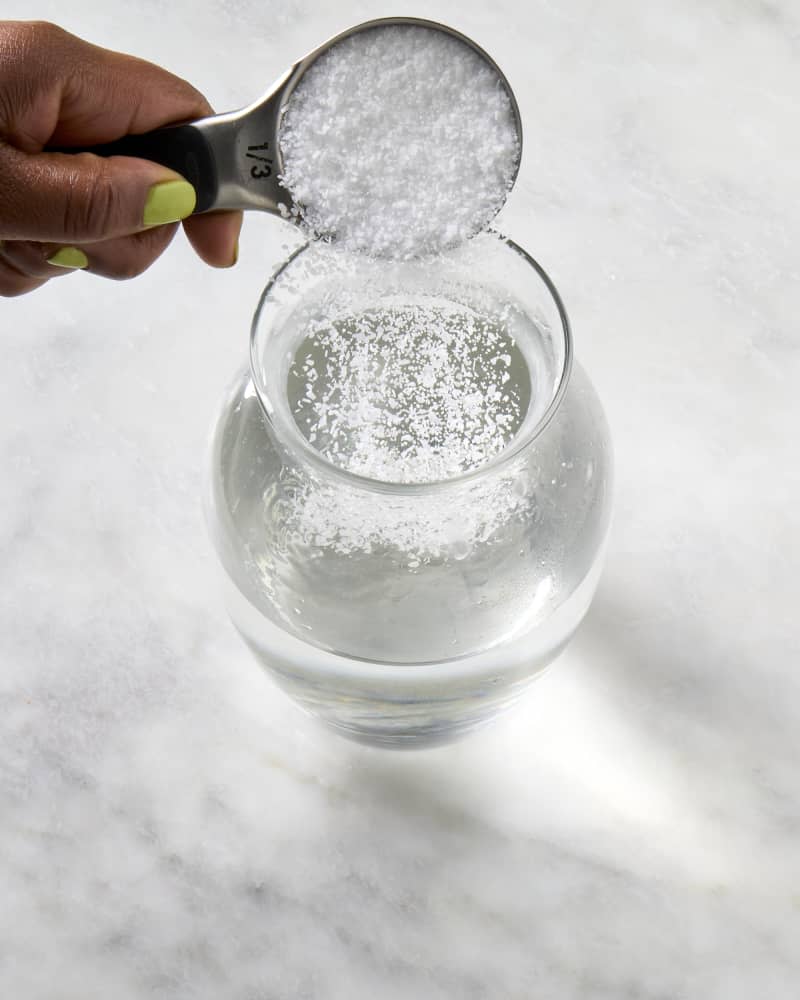
Glass Vase Cleaning Method: Salt and Water
Ease of use: 4.5/5
Performance: 4/5
Total time: 4/5
Overall: 4/5
The method: To use salt and water to clean out a glass vase, I filled the vase with warm water and about a third of a cup of salt. I left the solution in the vase for about 5 minutes, then covered the opening with my hand while I swirled the salt around in the vase to scrub against the stuck-on grime.
How it went: I really liked that this method required only very accessible ingredients: salt and warm water. It was easy to pour the salt into even a small-mouthed vase, and the whole process was fast. The vase cleaned with this method got cleaner than most of the aforementioned methods, too. I would definitely use this method again in the future.
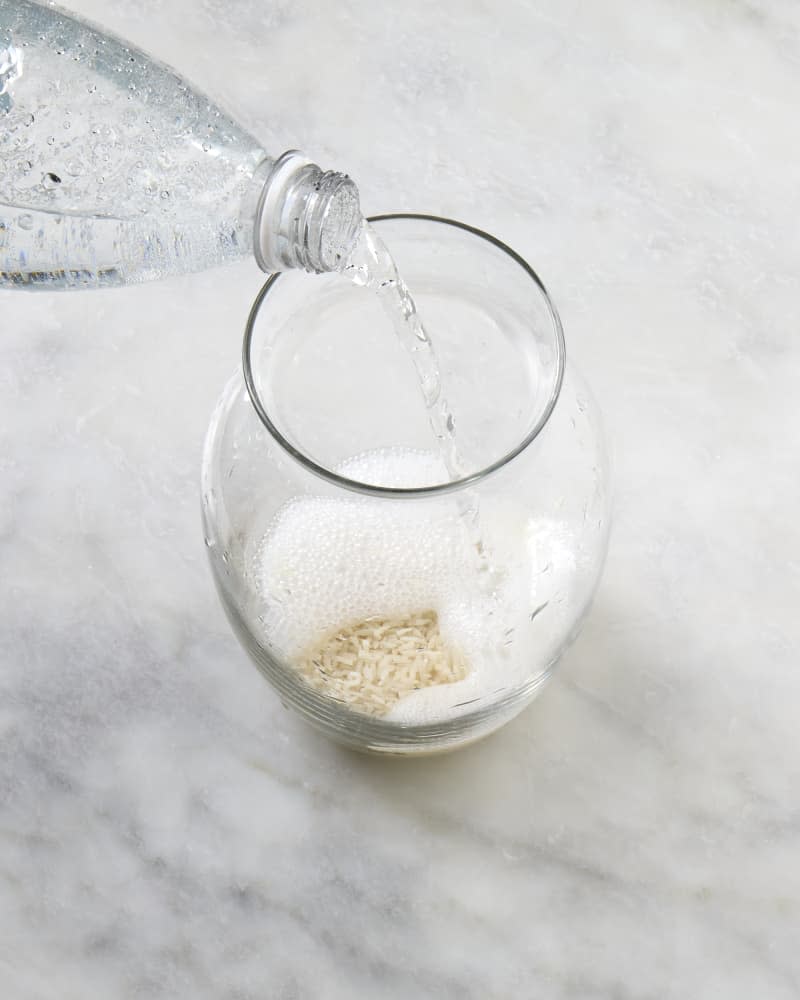
Glass Vase Cleaning Method: Uncooked Rice and Soda Water
Ease of use: 4/5
Performance: 5/5
Total time: 5/5
Overall: 5/5
The method: To use uncooked rice and soda water to clean out my dirty flower vase, I added a handful of dry rice (I used my favorite brand from Costco, but you can use any kind) to my vase using a cupped hand as a makeshift funnel. I then added soda water to the vase (all I had was flavored sparkling water, but plain soda water is ideal) until it was about three-quarters full. I covered the opening with my hand and shook the rice and soda water around. Then, I dumped out the rice and soda water, filled the vase with water, and dumped it out again.
How it went: This method was great! The larger grains of rice did a superior job of dislodging any stuck-on gunk both on the sides and bottom of the vase, unlike most of the other methods. The fizzing action of the water also seemed to make a significant difference in removing the dirt because I’ve tried this method with rice and plain water in the past, and it didn’t work nearly as well. The rice made a bit of a mess in the sink, but I just washed it down the garbage disposal — however, if you don’t have one, you can place a strainer above your drain. I also love that most people have fizzy water on hand, so there’s no need to buy any type of special cleaner or brush. This method produced the very best results of all five vase-cleaning methods I tried, and it was also one of the fastest from start to finish. It’s going to be my go-to method from now on!
The Winning Method
Mahatma Extra-Long-Grain Rice 2-Pound Rice Bag
The winning method — which I really didn’t expect to work as well as it did — happened to actually be an old bartender’s trick for cleaning tall, funky bottles: uncooked rice and soda water. Who would’ve thought! It requires only two ingredients you likely already have on hand, and if you don’t, are both edible (aka food-safe) and easy to find almost anywhere.
The long grains really helped get every little bit of dried-on organic material from inside the glasses — although other similarly shaped grains you have on hand would probably do the trick — and the fizzing action was enough to leave the glass sparkling. I’d recommend using cheaper rice, although it only takes about a cup’s worth so it doesn’t feel super wasteful. Plus, I was happy to find that even the flavored sparkling water worked wonders. Although the method was super easy, you do need to do some thorough shaking and swirling to make sure the rice and bubbles hit every last spot. I can’t wait to try this method again next week!
